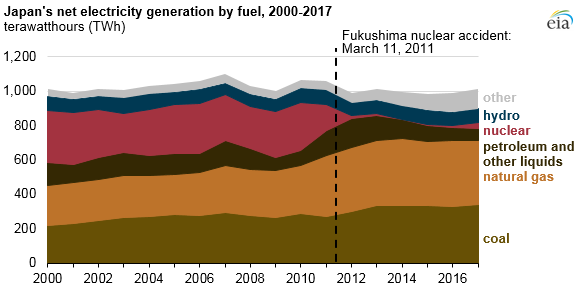Japan is Restarting Their Nuclear Power Plants: When Will Minnesota Legalize New Nuclear Power Plants?
Japan has taken aggressive steps to restart their nuclear power program by restarting five nuclear reactors in 2018. According to the Energy Information Administration, these nuclear reactors have a capacity of capacity of around six gigawatts (GW). For reference, this is more than Minnesota’s coal and nuclear capabilities, combined.

In total, more than 9 GW of nuclear capacity have come online since 2015 in Japan. If Minnesota had installed this same nuclear capacity, we would have been able to generate 100 percent of our electricity use with nearly zero carbon dioxide emissions. Instead, CO2 emissions from electricity generation in Minnesota have only fallen 25 percent since 2005, despite spending $15 billion on wind turbines.
This is because wind and solar simply cannot provide around-the-clock electricity, so we must burn coal and natural gas when the weather is not cooperating.
For example, in Minnesota, wind turbines produce electricity about 36 percent of the time, and solar panels produce electricity about 15.7 percent of the time, according to 2016 data from the EIA. This means when we build a wind turbine, natural gas or coal are still providing our electricity 64 percent of the time. When we build a solar installation, natural gas and coal are still providing our electricity 84.3 percent of the time.
Nuclear energy, however, operates around the clock, and therefore coal and natural gas would be essentially zeroed out.
The unreliability of wind and solar is why we always see an increase in fossil fuel use when countries like Japan when they shut down their nuclear plants. In fact, Japan saw their use of coal, natural gas, and oil increase dramatically after shuttering its nuclear fleet after the tsunami that hit Fukushima in 2011. According to EIA:
“The suspension of Japan’s nuclear fleet resulted in significantly greater dependence on liquefied natural gas (LNG), oil, and coal imports to make up for lost domestic nuclear generation. Japan has limited domestic energy resourcesand imports virtually all of the fossil fuels it uses. Therefore, Japan is the world’s largest importer of LNG and the third-largest importer of coal, behind India and China.”
“In 2017, natural gas accounted for nearly 37% of Japan’s electricity generation, followed by coal at 33%. LNG and coal imports rose last year as court injunctions delayed the planned restart of some nuclear reactors. Japan’s utilities spent approximately $30 billion each year for additional fossil fuel imports in the three years following the Fukushima accident.”
Despite nuclear’s actual ability to replace 100 percent of the coal and natural gas plants used to generate electricity, it is illegal to build a new power plant in Minnesota.
The DFL house wants to enact a 50 percent renewable energy mandate by 2030 to supposedly “save the planet” from climate change.This will be an expensive and ineffective policy.
If they actually cared about reducing CO2 emissions as quickly, and as permanently as possible, their first order of business would be to legalize nuclear energy.
